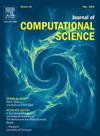采用标准蒙特卡罗、拟蒙特卡罗和拉丁超立方采样三种方法对萤火虫算法进行参数整定
IF 3.7
3区 计算机科学
Q2 COMPUTER SCIENCE, INTERDISCIPLINARY APPLICATIONS
引用次数: 0
摘要
在文献中有许多不同的受自然启发的算法,几乎所有这样的算法都有需要调优的算法相关参数。为了使所考虑的算法的性能最大化,需要进行适当的设置和参数调优。这项工作是Joy等人(2024)最近在国际计算科学会议(ICCS 2024)上提出的参数调优工作的扩展,萤火虫算法(FA)使用三种不同的方法进行调优:蒙特卡罗方法,准蒙特卡罗方法和拉丁超立方采样。然后利用参数调整后的遗传算法求解了6个不同的优化问题,并分析了参数设置对最优解质量的可能影响。进行了严格的统计假设检验,包括Student 's t检验、f检验、非参数Friedman检验和方差分析。结果表明,所采用的调谐方法对FA的性能没有影响。此外,调优的参数值在很大程度上与所使用的调优方法无关。这表明该算法在求解优化问题时既灵活又有效,三种调优方法中的任何一种都可以有效地对其参数进行调优。本文章由计算机程序翻译,如有差异,请以英文原文为准。

Parameter tuning of the firefly algorithm by three tuning methods: Standard Monte Carlo, quasi-Monte Carlo and latin hypercube sampling methods
There are many different nature-inspired algorithms in the literature, and almost all such algorithms have algorithm-dependent parameters that need to be tuned. The proper setting and parameter tuning should be carried out to maximize the performance of the algorithm under consideration. This work is the extension of the recent work on parameter tuning by Joy et al. (2024) presented at the International Conference on Computational Science (ICCS 2024), and the Firefly Algorithm (FA) is tuned using three different methods: the Monte Carlo method, the Quasi-Monte Carlo method and the Latin Hypercube Sampling. The FA with the tuned parameters is then used to solve a set of six different optimization problems, and the possible effect of parameter setting on the quality of the optimal solutions is analyzed. Rigorous statistical hypothesis tests have been carried out, including Student’s t-tests, F-tests, non-parametric Friedman tests and ANOVA. Results show that the performance of the FA is not influenced by the tuning methods used. In addition, the tuned parameter values are largely independent of the tuning methods used. This indicates that the FA can be flexible and equally effective in solving optimization problems, and any of the three tuning methods can be used to tune its parameters effectively.
求助全文
通过发布文献求助,成功后即可免费获取论文全文。
去求助
来源期刊

Journal of Computational Science
COMPUTER SCIENCE, INTERDISCIPLINARY APPLICATIONS-COMPUTER SCIENCE, THEORY & METHODS
CiteScore
5.50
自引率
3.00%
发文量
227
审稿时长
41 days
期刊介绍:
Computational Science is a rapidly growing multi- and interdisciplinary field that uses advanced computing and data analysis to understand and solve complex problems. It has reached a level of predictive capability that now firmly complements the traditional pillars of experimentation and theory.
The recent advances in experimental techniques such as detectors, on-line sensor networks and high-resolution imaging techniques, have opened up new windows into physical and biological processes at many levels of detail. The resulting data explosion allows for detailed data driven modeling and simulation.
This new discipline in science combines computational thinking, modern computational methods, devices and collateral technologies to address problems far beyond the scope of traditional numerical methods.
Computational science typically unifies three distinct elements:
• Modeling, Algorithms and Simulations (e.g. numerical and non-numerical, discrete and continuous);
• Software developed to solve science (e.g., biological, physical, and social), engineering, medicine, and humanities problems;
• Computer and information science that develops and optimizes the advanced system hardware, software, networking, and data management components (e.g. problem solving environments).
 求助内容:
求助内容: 应助结果提醒方式:
应助结果提醒方式:


